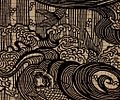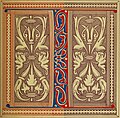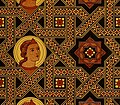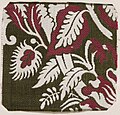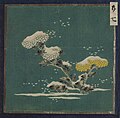De inlandsche kunstnijverheid in Nederlandsch Indië (1912)
[Detail] Embroidery and textile designs (1875)
[Detail] De inlandsche kunstnijverheid in Nederlandsch Indië (1912)
Floriated ornament: a series of thirty-one designs (1849)
[Detail] Examples of Chinese ornament selected from objects in the South Kensington museum and other collections (1867)
[Detail] The tapestries of the Vienna imperial court (1922)
[Detail] La décoration marocaine; cinquante-quatre planches accompagnées d'une préface et d'une table descriptive (1924)
[Detail] Swedish textiles (1925)
[Detail] The encyclopædia of ornament (1842)
Supplement, Latest Paris fashions, presented to the subscribers to the Queen (1877) Page 059
[Detail] The art of William Morris (1897)
[Detail] The encyclopædia of ornament (1842)
[Detail] Peasant art of subcarpathian Russia (1926)
[Detail] [Weaving pattern and sample book (1900)
[Detail] [Un metier de fabrique, avec la dénomination des diverses objects nécessaires à la fabrication de l'étoffe] (1835)
[Detail] Pattern book of silks and damasks (1700)
[Detail] Peasant art in Switzerland (1924)
"From a plaid found at Culloden" [Detail] Old and rare Scottish tartans, with historical introduction and descriptive notices (1893)
[Detail] Méthode de composition ornementale (1905)
[Detail] La décoration murale à Pompéi (1924)
[Detail] La décoration primitive : Océanie (1922
[Detail] La décoration primitive; Amérique post-Colombienne (1922)
[Detail] Livre de desseins d'Alexandre Lambert (1700)
[Detail] Éléments de composition décorative; cent thêmes de décoration plane (1912)
[Detail] Kunstgewerbe der Hindu (1924)
[Detail] Ideas & studies in stencilling & decorating (1927)
[Detail] Il ferro nell'arte italiana (1910) Cancello nella Sagrestia di S. Pietro Vaticano.
[Detail] Islamische Stoffe aus ägyptischen Gräbern in der Islamischen Kunstabteilung und in der Stoffsammlung des Schlossmuseums (1927)
[Detail] Italian peasant rugs (1923)
[Detail] "Hydron blue printed on cotton cloth..." Hydron blue G and R, patented paste 20% and powder (1911)
[Detail] Examples of Chinese ornament selected from objects in the South Kensington museum and other collections (1867)
[Detail] Der Ornamentenschatz; ein Musterbuch stilvoller Ornamente aus allen Kunstepochen (1887)
[Detail] Design in textile fabrics (1883)
[Detail] Collection of designs for household furniture and interior decoration, in the most approved and elegant taste (1808)
[Detail] Les accessoires du costume et du mobilier depuis le treizième jusqu'au milieu du dixneuvième siècle... Ouvrage contenant 393 phototypies, reproduisant plus de 3.000 documents (1928)
[Detail] Curtains & portières (1900)
[Detail] A history of English wallpaper, 1509–1914 (1926)
[Detail] A history of lace (1875)
[Detail] An encyclopaedia of colour decoration from the earliest times to the middle of the 19th century (1928)
[Detail] Art embroidery: a treatise on the revived practice of decorative needlework (1878)
[Detail] Weaving pattern and sample book (1900)
[Detail] Un metier de fabrique, avec la dénomination des diverses objects nécessaires à la fabrication de l'étoffe (1835)
[Detail] Étoffes imprimées et papiers peints (1924)
[Detail] The encyclopædia of ornament (1842)
[Detail] The dictionary of needlework : an encyclopædia of artistic, plain, and fancy needlework ... (1882)
[Detail] The color printer. A treatise on the use of colors in typographic printing (1892)
[Detail] The book of delightful and strange designs; being one hundred facsimile illustrations of the art of the Japanese stencil-cutter, to which the gentle reader is introduced (1893)
[Detail] The art of William Morris (1897)
[Detail] The art of illuminating as practiced in Europe from the earliest times (1860)
[Detail] Swedish textiles (1925)
[Detail] Oriental carpets, runners and rugs and some Jacquard reproductions .. (1910)
[Detail] Ornamental designs (1861)
An example of lace from the Italian Renaissance.
[Detail] Oriental cloth samples.
[Detail] Oriental cloth samples.
Dipsacus Spinosus Americanus. Naauwkeurige beschryving der aardgewassen, waar in de veelerley aart en bijzondere eigenschappen der boomen, heesters, kruyden, bloemen, met haare vrugten, zaden, wortelen en bollen, neevens derzelver waare voort-teeling, gelukkige aanwinning, en heylzaame genees-krachten ... beschreeven worden; (1696)
[Detail] Insegna dell'Arte della lana. S. Miniato (Firenze) Il ferro nell'arte italiana; (1910)
[Detail] Pattern book of silks and damasks (1700)
[Detail] Der Ornamentenschatz; ein Musterbuch stilvoller Ornamente aus allen Kunstepochen (1887)
Detail. Mac Laine of Lochbuie. Old and rare Scottish tartans, with historical introduction and descriptive notices (1893)
[Detail] The art of weaving, by hand and by power, : with an introductory account of its rise and progress in ancient and modern times. For the use of manufacturers and others. (1844)
[Detail] Japanese decorated silk.
[Detail] A treatise on lace-making, embroidery, and needle-work... (1892-[1900])
[Detail] Der Ornamentenschatz; ein Musterbuch stilvoller Ornamente aus allen Kunstepochen (1887)
[Detail] Japanese decorated silk.
[Detail] Collection Empire.
[Detail] Collection Empire. In the Mary Ann Beinecke Decorative Art Collection. Sterling and Francine Clark Art Institute Library.
https://archive.org/stream/MAB.31962000743264Images_201304/MAB.31962000743264#page/n19/mode/2up [Detail] Collection Empire. In the Mary Ann Beinecke Decorative Art Collection. Sterling and Francine Clark Art Institute Library.
https://archive.org/stream/MAB.31962000743264Images_201304/MAB.31962000743264#page/n45/mode/2up [Detail] The book of delightful and strange designs; being one hundred facsimile illustrations of the art of the Japanese stencil-cutter, to which the gentle reader is introduced (1893) In the Mary Ann Beinecke Decorative Art Collection. Sterling and Francine Clark Art Institute Library.
https://archive.org/stream/bookofdelightful00tuer#page/n115/mode/2up [Detail] [Fabric sample book] (1863) In the Mary Ann Beinecke Decorative Art Collection. Sterling and Francine Clark Art Institute Library.
https://archive.org/stream/MAB.31962000742175Images/MAB.31962000742175_Images#page/n43/mode/2up [Detail] Designs selected from Ukiyoe prints (1860) In the Mary Ann Beinecke Decorative Art Collection. Sterling and Francine Clark Art Institute Library.
https://archive.org/stream/MAB.NK1484U4Images_20130423/MAB.NK1484%20U4_Images#page/n37/mode/2up [Detail] [Sample book of trims] (1800) In the Mary Ann Beinecke Decorative Art Collection. Sterling and Francine Clark Art Institute Library.
https://archive.org/stream/MAB.31962000742936Images/MAB.31962000742936_Images#page/n37/mode/2up [Detail] "Shinsen Kodaimoyo Kangami."
: Nueva serie de modelos de Antiguas telas (1882) In the Mary Ann Beinecke Decorative Art Collection. Sterling and Francine Clark Art Institute Library.
https://archive.org/stream/MAB.31962000745293Images/MAB.31962000745293__Images#page/n23/mode/2up [Detail] [Weaving design book] (1890) In the Mary Ann Beinecke Decorative Art Collection. Sterling and Francine Clark Art Institute Library.
https://archive.org/stream/MAB.31962000742555Images/MAB.31962000742555_Images#page/n33/mode/2up [Detail] [Sample book of trims] (1800) In the Mary Ann Beinecke Decorative Art Collection. Sterling and Francine Clark Art Institute Library.
https://archive.org/stream/MAB.31962000742936Images/MAB.31962000742936_Images#page/n39/mode/2up COMMON HEAL-ALL. Wild flowers of America
: flowers of every state in the American Union / by a corps of special artists and botanists (1894) In the Mary Ann Beinecke Decorative Art Collection. Sterling and Francine Clark Art Institute Library.
https://archive.org/stream/MAB.31962004370114Images/MAB.31962004370114_Images#page/n5/mode/2up [Detail] Japanese designs from Ukiyoe prints (1800) In the Mary Ann Beinecke Decorative Art Collection. Sterling and Francine Clark Art Institute Library.
https://archive.org/stream/MAB.31962000726566Images/MAB.31962000726566_Images#page/n25/mode/2up [Detail] Der Ornamentenschatz; ein Musterbuch stilvoller Ornamente aus allen Kunstepochen (1887) In the Mary Ann Beinecke Decorative Art Collection. Sterling and Francine Clark Art Institute Library.
https://archive.org/stream/derornamentensch00dolm#page/n69/mode/2up [Detail] Lobre Frères, Lyon. [Sample book of trims] (1800) In the Mary Ann Beinecke Decorative Art Collection. Sterling and Francine Clark Art Institute Library.
https://archive.org/stream/MAB.31962000742936Images/MAB.31962000742936_Images#page/n55/mode/2up [Detail] Lace collection, 19th century. In the Mary Ann Beinecke Decorative Art Collection. Sterling and Francine Clark Art Institute Library.
https://archive.org/stream/MAB.31962000792055Images/MAB.31962000792055_Images#page/n15/mode/2up [Detail] Passementeries (1842) In the Mary Ann Beinecke Decorative Art Collection. Sterling and Francine Clark Art Institute Library.
https://archive.org/stream/MAB.31962000742977Images/MAB.31962000742977_Images#page/n17/mode/2up [Detail] "Shinsen Kodaimoyo Kangami."
: Nueva serie de modelos de Antiguas telas / por Kodama (1882) In the Mary Ann Beinecke Decorative Art Collection. Sterling and Francine Clark Art Institute Library.
https://archive.org/stream/MAB.31962000745293Images/MAB.31962000745293__Images#page/n13/mode/2up GROUND CHERRY. Wild flowers of America
: flowers of every state in the American Union / by a corps of special artists and botanists (1894) In the Mary Ann Beinecke Decorative Art Collection. Sterling and Francine Clark Art Institute Library.
https://archive.org/stream/MAB.31962004370056Images/MAB.31962004370056_Images#page/n13/mode/2up [Detail] Japanese decorated silk (1700) In the Mary Ann Beinecke Decorative Art Collection. Sterling and Francine Clark Art Institute Library.
https://archive.org/stream/MAB.31962000745236Images_20130422/MAB.31962000745236__images#page/n19/mode/2up [Detail] Patterns and designs. In the Mary Ann Beinecke Decorative Art Collection. Sterling and Francine Clark Art Institute Library.
https://archive.org/stream/MAB.31962000795432Images_201305/MAB.31962000795432_Images#page/n13/mode/2up L'honesto essempio del uertuoso desiderio che hanno le donne di nobil ingegno
: circa lo imparare i punti tagliati a fogliami (1550) In the Mary Ann Beinecke Decorative Art Collection. Sterling and Francine Clark Art Institute Library.
https://archive.org/stream/MAB.31962000791461Images/MAB.31962000791461_Images#page/n11/mode/2up Lincoln Lace. Lace instructions,1859 Jan. 22 (1859) In the Mary Ann Beinecke Decorative Art Collection. Sterling and Francine Clark Art Institute Library.
https://archive.org/stream/MAB.31962000793137Images/MAB.31962000793137_Images#page/n55/mode/2up [Detail] Passementeries (1842) In the Mary Ann Beinecke Decorative Art Collection. Sterling and Francine Clark Art Institute Library.
https://archive.org/stream/MAB.31962000742977Images/MAB.31962000742977_Images#page/n61/mode/2up Japanese designs from Ukiyoe prints (1800) In the Mary Ann Beinecke Decorative Art Collection. Sterling and Francine Clark Art Institute Library.
https://archive.org/stream/MAB.31962000726566Images_20130507/MAB.31962000726566_Images#page/n7/mode/2up [Japanese designs] In the Mary Ann Beinecke Decorative Art Collection. Sterling and Francine Clark Art Institute Library.
https://archive.org/stream/MAB.31962000726541Images/MAB.31962000726541__Images#page/n39/mode/2up Album de tapisserie / [par] N. Alexandre & Cie., éditeurs, dessinateurs. Nos. 57, 240, 243, and 250. In the Mary Ann Beinecke Decorative Art Collection. Sterling and Francine Clark Art Institute Library.
https://archive.org/stream/MAB.31962004370221Images/MAB.31962004370221_Images#page/n3/mode/2up "Shinsen Kodaimoyo Kangami."
: Nueva serie de modelos de Antiguas telas / por Kodama (1882) In the Mary Ann Beinecke Decorative Art Collection. Sterling and Francine Clark Art Institute Library.
https://archive.org/stream/MAB.31962000745293Images/MAB.31962000745293__Images#page/n29/mode/2up [Detail] Lobre Frères, Lyon. [Sample book of trims] (1800) In the Mary Ann Beinecke Decorative Art Collection. Sterling and Francine Clark Art Institute Library.
https://archive.org/stream/MAB.31962000742936Images/MAB.31962000742936_Images#page/n33/mode/2up Cat-Mint. Wild flowers of America
: flowers of every state in the American Union / by a corps of special artists and botanists (1894) In the Mary Ann Beinecke Decorative Art Collection. Sterling and Francine Clark Art Institute Library.
https://archive.org/stream/MAB.31962004370049Images/MAB.31962004370049_Images#page/n11/mode/2up [Detail] Collection Empire (1900) In the Mary Ann Beinecke Decorative Art Collection. Sterling and Francine Clark Art Institute Library.
https://archive.org/stream/MAB.31962000743264Images_201304/MAB.31962000743264#page/n201/mode/2up [Detail] Oriental cloth samples. In the Mary Ann Beinecke Decorative Art Collection. Sterling and Francine Clark Art Institute Library.
https://archive.org/stream/NK8872O71/NK8872%20O71#page/n17/mode/2up Six steps in tying a scarf. Florence home needle-work (1892) In the Mary Ann Beinecke Decorative Art Collection. Sterling and Francine Clark Art Institute Library.
https://archive.org/stream/MAB.31962000794853Images/MAB.31962000794853_Images#page/n33/mode/2up [Detail] Passementeries (1842) In the Mary Ann Beinecke Decorative Art Collection. Sterling and Francine Clark Art Institute Library.
https://archive.org/stream/MAB.31962000742977Images/MAB.31962000742977_Images#page/n35/mode/2up Embroidered edgings
: job lot offer, ref. 812 (1860) In the Mary Ann Beinecke Decorative Art Collection. Sterling and Francine Clark Art Institute Library.
https://archive.org/stream/MAB.31962000791701Images/MAB.31962000791701#page/n3/mode/2up Detail. Passementeries (1842) In the Mary Ann Beinecke Decorative Art Collection. Sterling and Francine Clark Art Institute Library.
https://archive.org/stream/MAB.31962000742977Images/MAB.31962000742977_Images#page/n7/mode/2up Album de tapisserie / [par] N. Alexandre & Cie., éditeurs, dessinateurs. Nos. 57, 240, 243, and 250 ([n.d.]) In the Mary Ann Beinecke Decorative Art Collection. Sterling and Francine Clark Art Institute Library.
https://archive.org/stream/MAB.31962004370221Images/MAB.31962004370221_Images#page/n5/mode/2up [Detail] Der Ornamentenschatz; ein Musterbuch stilvoller Ornamente aus allen Kunstepochen (1887) In the Mary Ann Beinecke Decorative Art Collection. Sterling and Francine Clark Art Institute Library.
https://archive.org/stream/derornamentensch00dolm#page/n123/mode/2up Cognoscite lilia agri quomodo crescent (1614) In the Mary Ann Beinecke Decorative Art Collection. Sterling and Francine Clark Art Institute Library.
https://archive.org/stream/cognosciteliliaa00pass#page/n13/mode/2up [Detail] De la fabrique d'étoffes (1842) In the Mary Ann Beinecke Decorative Art Collection. Sterling and Francine Clark Art Institute Library.
https://archive.org/stream/delafabriquedtof00unse#page/n47/mode/2up Octagon Boudoir—Adams style. The practical cabinet maker ... (1910) In the Mary Ann Beinecke Decorative Art Collection. Sterling and Francine Clark Art Institute Library.
https://archive.org/stream/practicalcabinet1910hodg#page/182/mode/2up [Detail] Passementeries (1842) In the Mary Ann Beinecke Decorative Art Collection. Sterling and Francine Clark Art Institute Library.
https://archive.org/stream/MAB.31962000742977Images/MAB.31962000742977_Images#page/n65/mode/2up Japanese designs from Ukiyoe prints (1860?) In the Mary Ann Beinecke Decorative Art Collection. Sterling and Francine Clark Art Institute Library.
https://archive.org/stream/MAB.31962000726566Images_20130507/MAB.31962000726566_Images#page/n13/mode/2up [Detail] [Weaving design book] (1890) In the Mary Ann Beinecke Decorative Art Collection. Sterling and Francine Clark Art Institute Library.
https://archive.org/stream/MAB.31962000742555Images/MAB.31962000742555_Images#page/n39/mode/2up The Forest Wreath. Leaf and flower pictures, and how to make them (1859) In the Mary Ann Beinecke Decorative Art Collection. Sterling and Francine Clark Art Institute Library.
https://archive.org/stream/MAB.NK1560L41859Images_201304/MAB.NK1560%20L4%201859_Images#page/n25/mode/2up [Detail] New products manufactured by Farbwerke vorm. Meister Lucius & Brüning, Hoechst on the Main, Germany. (1900) In the Mary Ann Beinecke Decorative Art Collection. Sterling and Francine Clark Art Institute Library.
https://archive.org/stream/MAB.31962004184572Images/MAB.31962004184572_Images#page/n59/mode/2up Egypte. Spécimens de la décoration et de l'ornementation au XIXe siècle ([1872]) In the Mary Ann Beinecke Decorative Art Collection. Sterling and Francine Clark Art Institute Library.
https://archive.org/stream/CAI1077440001Images/CAI_107744_0001_Images#page/n133/mode/2up De la fabrique d'étoffes (1842) In the Mary Ann Beinecke Decorative Art Collection. Sterling and Francine Clark Art Institute Library.
https://archive.org/stream/samplebookoffren00mais/b11719217#page/n61/mode/2up [Detail] Sample book of French embroidery, 1850? In the Mary Ann Beinecke Decorative Art Collection. Sterling and Francine Clark Art Institute Library.
https://archive.org/stream/delafabriquedtof00unse#page/n76/mode/1up Japanese decorated silk (1700) In the Mary Ann Beinecke Decorative Art Collection. Sterling and Francine Clark Art Institute Library.
https://archive.org/stream/MAB.31962000745236Images_20130422/MAB.31962000745236__images#page/n23/mode/2up [Detail] French fabric sample book (1900) In the Mary Ann Beinecke Decorative Art Collection. Sterling and Francine Clark Art Institute Library.
https://archive.org/stream/frenchfabricsamp00unse#page/15163/mode/2up [Detail] [French textiles] (1863) In the Mary Ann Beinecke Decorative Art Collection. Sterling and Francine Clark Art Institute Library.
https://archive.org/stream/frenchtextiles00unse#page/n47/mode/2up [Detail] [French silk sample book (1895) In the Mary Ann Beinecke Decorative Art Collection. Sterling and Francine Clark Art Institute Library.
https://archive.org/stream/frenchsilksample00unse#page/n201/mode/2up [Detail] [Silk ribbons and trims] (1886) In the Mary Ann Beinecke Decorative Art Collection. Sterling and Francine Clark Art Institute Library.
https://archive.org/stream/silkribbonstrims00elem#page/n79/mode/1up Examples of Chinese ornament selected from objects in the South Kensington museum and other collections (1867) In the Mary Ann Beinecke Decorative Art Collection. Sterling and Francine Clark Art Institute Library.
https://archive.org/stream/examplesofchines1867jone#page/n103/mode/2up
![[Detail] The book of delightful and strange designs; being one hundred facsimile illustrations of the art of the Japanese stencil-cutter, to which the gentle reader is introduced (1893) In the Mary Ann Beinecke Decorative Art Collection. Sterling and Francine Clark Art Institute Library. https://archive.org/stream/bookofdelightful00tuer#page/n115/mode/2up Japanesedecoratedsilk 0016.jpg](http://upload.wikimedia.org/wikipedia/commons/thumb/e/e4/Japanesedecoratedsilk_0016.jpg/330px-Japanesedecoratedsilk_0016.jpg)
![[Detail] Japanese decorated silk. In the Mary Ann Beinecke Decorative Art Collection. Sterling and Francine Clark Art Institute Library. https://archive.org/stream/Japanesedecoratedsilk#page/n15/mode/2up Japanesedecoratedsilk 0007.jpg](http://upload.wikimedia.org/wikipedia/commons/thumb/d/dc/Japanesedecoratedsilk_0007.jpg/330px-Japanesedecoratedsilk_0007.jpg)
![[Detail] Etoffes imprimees et papiers peints (1924) In the Mary Ann Beinecke Decorative Art Collection. Sterling and Francine Clark Art Institute Library. https://archive.org/stream/toffesimprimeset00mous#page/n41/mode/2up Toffesimprimeset00mous 0043.jpg](http://upload.wikimedia.org/wikipedia/commons/thumb/e/ec/Toffesimprimeset00mous_0043.jpg/330px-Toffesimprimeset00mous_0043.jpg)
![[Detail] Floriated ornament: a series of thirty-one designs (1849) In the Mary Ann Beinecke Decorative Art Collection. Sterling and Francine Clark Art Institute Library. https://archive.org/stream/floriatedornamen00pugi#page/n127/mode/2up Floriated ornament.jpg](http://upload.wikimedia.org/wikipedia/commons/thumb/4/43/Floriated_ornament.jpg/330px-Floriated_ornament.jpg)
![[Detail] De inlandsche kunstnijverheid in Nederlandsch Indie (1912) In the Mary Ann Beinecke Decorative Art Collection. Sterling and Francine Clark Art Institute Library. https://archive.org/stream/deinlandschekuns01jasp#page/94/mode/2up Detail. De inlandsche kunstnijverheid in Nederlandsch Indie (1912).jpg](http://upload.wikimedia.org/wikipedia/commons/thumb/e/e8/Detail._De_inlandsche_kunstnijverheid_in_Nederlandsch_Indi%C3%AB_%281912%29.jpg/330px-Detail._De_inlandsche_kunstnijverheid_in_Nederlandsch_Indi%C3%AB_%281912%29.jpg)
![[Detail] Embroidery and textile designs (1875) In the Mary Ann Beinecke Decorative Art Collection. Sterling and Francine Clark Art Institute Library. https://archive.org/stream/embroiderytextil00np#page/n209/mode/2up. Embroiderytextil00np 0210.jpg](http://upload.wikimedia.org/wikipedia/commons/thumb/1/1e/Embroiderytextil00np_0210.jpg/330px-Embroiderytextil00np_0210.jpg)
![[Detail] De inlandsche kunstnijverheid in Nederlandsch Indie (1912) In the Mary Ann Beinecke Decorative Art Collection. Sterling and Francine Clark Art Institute Library. https://archive.org/stream/deinlandschekuns03jasp#page/40/mode/2up De inlandsche kunstnijverheid in Nederlandsch Indie.jpg](http://upload.wikimedia.org/wikipedia/commons/thumb/3/3a/De_inlandsche_kunstnijverheid_in_Nederlandsch_Indi%C3%AB.jpg/330px-De_inlandsche_kunstnijverheid_in_Nederlandsch_Indi%C3%AB.jpg)
!["From a plaid found at Culloden" [Detail] Old and rare Scottish tartans, with historical introduction and descriptive notices (1893) In the Mary Ann Beinecke Decorative Art Collection. Sterling and Francine Clark Art Institute Library. https://archive.org/stream/oldrarescottisht00stew#page/n253/mode/2up Oldrarescottisht00stew 0255.jpg](http://upload.wikimedia.org/wikipedia/commons/thumb/0/0e/Oldrarescottisht00stew_0255.jpg/330px-Oldrarescottisht00stew_0255.jpg)
![[Detail] Swedish textiles (1925) In the Mary Ann Beinecke Decorative Art Collection. Sterling and Francine Clark Art Institute Library. https://archive.org/stream/swedishtextiles00nord#page/n133/mode/2up Swedishtextiles00nord 0135.jpg](http://upload.wikimedia.org/wikipedia/commons/thumb/0/0d/Swedishtextiles00nord_0135.jpg/330px-Swedishtextiles00nord_0135.jpg)
![[Detail] The encyclopaedia of ornament (1842)In the Mary Ann Beinecke Decorative Art Collection. Sterling and France Clark Art Institute Library. https://archive.org/stream/encyclopdiaoforn00shaw#page/n89/mode/2up Encyclopdiaoforn00shaw 0091.jpg](http://upload.wikimedia.org/wikipedia/commons/thumb/7/73/Encyclopdiaoforn00shaw_0091.jpg/330px-Encyclopdiaoforn00shaw_0091.jpg)
![[Detail] The encyclopaedia of ornament (1842)In the Mary Ann Beinecke Decorative Art Collection. Sterling and France Clark Art Institute Library. https://archive.org/stream/encyclopdiaoforn00shaw#page/n177/mode/2up Encyclopdiaoforn00shaw 0179 (1).jpg](http://upload.wikimedia.org/wikipedia/commons/thumb/e/e7/Encyclopdiaoforn00shaw_0179_%281%29.jpg/330px-Encyclopdiaoforn00shaw_0179_%281%29.jpg)
![[Detail] Il ferro nell'arte italiana (1910) Cancello nella Sagrestia di S. Pietro Vaticano. In the Mary Ann Beinecke Decorative Art Collection. Sterling and Francine Clark Art Institute Library. https://archive.org/stream/ilferronellartei00ferr#page/214/mode/2up Ilferronellartei00ferr 0223.jpg](http://upload.wikimedia.org/wikipedia/commons/thumb/2/2e/Ilferronellartei00ferr_0223.jpg/330px-Ilferronellartei00ferr_0223.jpg)
![[Detail] Examples of Chinese ornament selected from objects in the South Kensington museum and other collections (1867) In the Mary Ann Beinecke Decorative Art Collection. Sterling and Francine Clark Art Institute Library. https://archive.org/stream/examplesofchines1867jone#page/n183/mode/2up Examplesofchines1867jone 0185.jpg](http://upload.wikimedia.org/wikipedia/commons/thumb/5/50/Examplesofchines1867jone_0185.jpg/330px-Examplesofchines1867jone_0185.jpg)












































